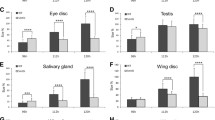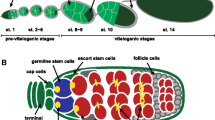Abstract
Adult body plan differentiation in holometabolous insects depends on global induction and control by ecdysteroid hormones during the final phase of postembryogenesis. Studies in Drosophila melanogaster and Manduca sexta have shown that this pertains also to the development of the compound eye retina. It is unclear whether the hormonal control of postembryonic eye development in holometabolous insects represents evolutionary novelty or heritage from hemimetabolous insects, which develop compound eyes during embryogenesis. We therefore investigated the effect of manipulating ecdysteroid signaling in cultured embryonic eye primordia of the American desert locust Schistocerca americana, in which ecdysteroid level changes are known to induce three rounds of embryonic molt. Although at a considerably reduced rate compared to in vivo development, early differentiation and terminal maturation of the embryonic retina was observed in culture even if challenged with the ecdysteroid antagonist cucurbitacin B. Supplementing cultures with 20-hydroxyecdysone (20E) accelerated differentiation and maturation, and enhanced cell proliferation. Considering these results, and the relation between retina differentiation and ecdysteroid level changes during locust embryogenesis, we conclude that ecdysteroids are not an essential but possibly a modulatory component of embryonic retina development in S. americana. We furthermore found evidence that 20E initiated precocious epithelial morphogenesis of the posterior retinal margin indicating a more general role of ecdysteroids in insect embryogenesis.







Similar content being viewed by others
References
Bender M, Imam FB, Talbot W, Ganetzky B, Hogness D (1997) Drosophila ecdysone receptor mutations reveal functional differences among receptor isoforms. Cell 91:777–788
Bentley D, Keshishian H, Shankland M, Toroian-Raymond A (1979) Quantitative staging of embryonic development of the grasshopper, Schistocerca nitens. J Embryol Exp Morphol 54:47–74
Brennan CA, Ashburner M, Moses K (1998) Ecdysone pathway is required for furrow progression in the developing Drosophila eye. Development 125:2653–2664
Brennan CA, Li TR, Bender M, Hsiung F, Moses K (2001) Broad-complex, but not ecdysone receptor, is required for progression of the morphogenetic furrow in the Drosophila eye. Development 128:1–11
Champlin DT, Truman JW (1998) Ecdysteroids govern two phases of eye development during metamorphosis of the moth, Manduca sexta. Development 125:2009–2018
Chavez M, Marques G, Delpecque J, Kobayashi K, Holingsworth M, et al (2000) The Drosophila disembodied gene controls late embryonic morphogenesis and codes for a cytochrome P450 enzyme that regulates embryonic ecdysone levels. Development 127:4115–4126
Cherbas L, Lee K, Cherbas P (1991) Identification of ecdysone response elements by analysis of the Drosophila Elp28/29 gene. Genes Dev 5:120–131
Cherbas L, Hu X, Zhimulev I, Belyaeva E, Cherbas P (2003) EcR isoforms in Drosophila: testing tissue-specific requirements by targeted blockade and rescue. Development 130:271–284
Denlinger DL (1985) Hormonal control of diapause. In: Kerkut GA, Gilbert LI (eds) Comprehensive insect physiology, biochemistry and pharmacology. Pergamon Press, Oxford, pp 353–412
Dinan L, Whiting P, Girault JP, Lafont R, Dhadialla TS, et al (1997) Cucurbitacins are insect steroid hormone antagonists acting at the ecdysteroid receptor. Biochem J 327:643–650
Dinan LN, Rees HH (1981) The identification and titres of conjugated and free ecdysteroids in developing ovaries and newly-laid eggs of Schistocerca gregaria. J Insect Physiol 27:51–58
Gande AR, Morgan ED (1979) Ecdysteroids in the developing eggs of the desert locust, Schistocerca gregaria. J Insect Physiol 25:289–293
Ghbeish N, McKeown M (2002) Analyzing the repressive function of ultraspiracle, the Drosophila RXR, in Drosophila eye development. Mech Dev 111:89–98
Giesen K, Lammel U, Langehans D, Krukkert K, Bunse I, et al (2003) Regulation of glial cell number and differentiation by ecdysone and Fos signaling. Mech Dev 120:401–413
Hayward D, Bastiani MJ, Trueman J, Truman J, Riddiford LM, et al (1999) The sequence of Locusta RXR, homologous to Drosophila Ultraspiracle, and its evolutionary implications. Dev Genes Evol 209:564–571
Hoffmann JA, Lagueux M (1985) Endocrine aspects of embryonic development in insects. In: Kerkut GA, Gilbert LI (eds) Comprehensive insect physiology, biochemistry and pharmacology. Pergamon Press, Oxford, pp 435–460
Kuitert LC, Connin RV (1952) Biology of the American grasshopper in the southeastern United States. Fla Entomol 35:22–33
Lagueux M, Hetru C, Coltzene F, Kappler C, Hoffmann JA (1979) Ecdysone titre and metabolism in relation to cuticulogenesis in embryos of Locusta migratoria. J Insect Physiol 25:709–723
Li C, Meinertzhagen IA (1995) Conditions for the primary culture of eye imaginal discs from Drosophila melanogaster. J Neurobiol 28:363–380
Li C, Meinertzhagen IA (1997) The effects of 20-hydroxyecdysone on the differentiation in vitro of cells from the eye imaginal disc from Drosophila melanogaster. Invert Neurosci 3:57–69
Longley RL Jr, Ready DF (1995) Integrins and the development of three-dimensional structure in the Drosophila compound eye. Dev Biol 171:415–433
Makka T, Seino A, Tomita S, Fujiwara H, Sonobe H (2002) A possible role of 20-hydroxyecdysone in embryonic development of the silkworm Bombyx mori. Arch Insect Biochem 51:111–120
Morgan ED, Poole CF (1976) The pattern of ecdysone levels during development in the desert locust, Schistocerca gregaria. J Insect Physiol 22:885–889
Mueller NS (1963) An experimental analysis of molting in embryos of Melanoplus differentialis. Dev Biol 8:222–240
Myers PZ, Bastiani MJ (1993) Growth cone dynamics during the migration of an identified commissural growth cone. J Neurosci 13:127–143
Nijhout HF (1994) Insect hormones. Princeton University Press, Princeton, N.J.
Oro AE, McKeown M, Evans RM (1992) The Drosophila retinoid X receptor homolog ultraspiracle functions in both female and eye morphogenesis. Development 119:462
Orsulic S, Peifer M (1994) A method to stain nuclei of Drosophila for confocal microscopy. Biotechniques 16:441–447
Riddiford LM (1993) Hormones and Drosophila development. In: Lawrence P, Martinez AM (eds) The development of Drosophila melanogaster. Cold Spring Harbour Laboratory Press, Cold Spring Harbor, N.Y., pp 899–939
Riddiford LM, Cherbas P, Truman JW (2001) Ecdysone receptors and their biological actions. Vitam Horm NY 60:1–67
Saleh DS, Zhang J, Wyatt G, Walker V (1998) Cloning and characterization of an ecdysone receptor cDNA from Locusta migratoria. Mol Cell Endocrinol 143:91–99
Sall C, Tsourpas G, Kappler C, Lagueux M, Zachary D, et al (1983) Fate of maternal conjugated ecdysteroids during embryonic development in Locusta migratoria. J Insect Physiol 29:491–507
Sbrenna G, Chicca M, Bonora M, Sbrenna Micciarelli A (1989) The response of embryonic epidermal tissue of Schistocerca gregaria (Orhoptera, Acrididae) to 20-OH-ecdysone in vitro. Acta Embryol Exp Morphol 10:221–226
Scalia S, Morgan ED (1982) A re-investigation of the ecdysteroids during embryogenesis in the desert locust, Schistocerca gregaria. J Insect Physiol 28:647–654
Scalia S, Sbrenna-Micciarelli A, Sbrenna G, Morgan ED (1987) Ecdysteroid titres and location in developing eggs of Schistocerca gregaria. Insect Biochem 17:227–236
Schubiger M, Truman JW (2000) The RXR-ortholog USP suppresses early metamorphic processes in the absence of ecdysteroids. Development 127:1151–1159
Slama K (2000) Correlation between metabolic depression and ecdysteroid peak during embryogenesis of the desert locust, Schistocerca gregaria. Eur J Entomol 97:141–148
Tawfik AI, Tanaka Y, Tanaka S (2002) Possible involvement of ecdysteroids in embryonic diapause of Locusta migratoria. J Insect Physiol 48:743–749
Thummel CS (1996) Flies on steroids—Drosophila metamorphosis and the mechanisms of steroid hormone action. Trends Genet 12:306–310
Truman JW, Riddiford LM (1999) The origins of insect metamorphosis. Nature 401:447–452
Truman JW, Riddiford LM (2002) Endocrine insights into the evolution of metamorphosis in insects. Annu Rev Entomol 47:467–500
Tsai C, Kao H, Yao T, McKeown M, Evans R (1999) SMRTER, a Drosophila nuclear receptor coregulator, reveals that EcR-mediated repression is critical for development. Mol Cell 4:175–186
Whiting P, Sparks S, Dinan LN (1993) Ecdysteroids during embryogenesis of the house cricket, Acheta domesticus: occurrence of novel ecdysteroid conjugates in developing eggs. Insect Biochem Mol Biol 23:319–329
Wolff T, Ready D (1993) Pattern formation in the Drosophila retina. In: Lawrence P, Martinez AM (eds) The development of Drosophila melanogaster. Cold Spring Harbour Laboratory Press, Cold Spring Harbor, N.Y., pp 1277–1326
Zelhof AC, Ghbeish N, Tsai C, Evans RM, McKeown M (1997) A role for Ultraspiracle, the Drosophila RXR, in morphogenetic furrow movement and photoreceptor cluster formation. Development 124:2499–2506
Acknowledgements
We are grateful to Kaushiki Menon, Kai Zinn, Nipam Patel and Barry Condron for helping out with grasshopper embryos at times of drought. This work was supported by NSF grants DBI-0070099 and DBI-0091926.
Author information
Authors and Affiliations
Corresponding author
Additional information
Edited by C. Desplan
Electronic Supplementary Material
Rights and permissions
About this article
Cite this article
Dong, Y., Dinan, L. & Friedrich, M. The effect of manipulating ecdysteroid signaling on embryonic eye development in the locust Schistocerca americana . Dev Genes Evol 213, 587–600 (2003). https://doi.org/10.1007/s00427-003-0367-z
Received:
Accepted:
Published:
Issue Date:
DOI: https://doi.org/10.1007/s00427-003-0367-z






